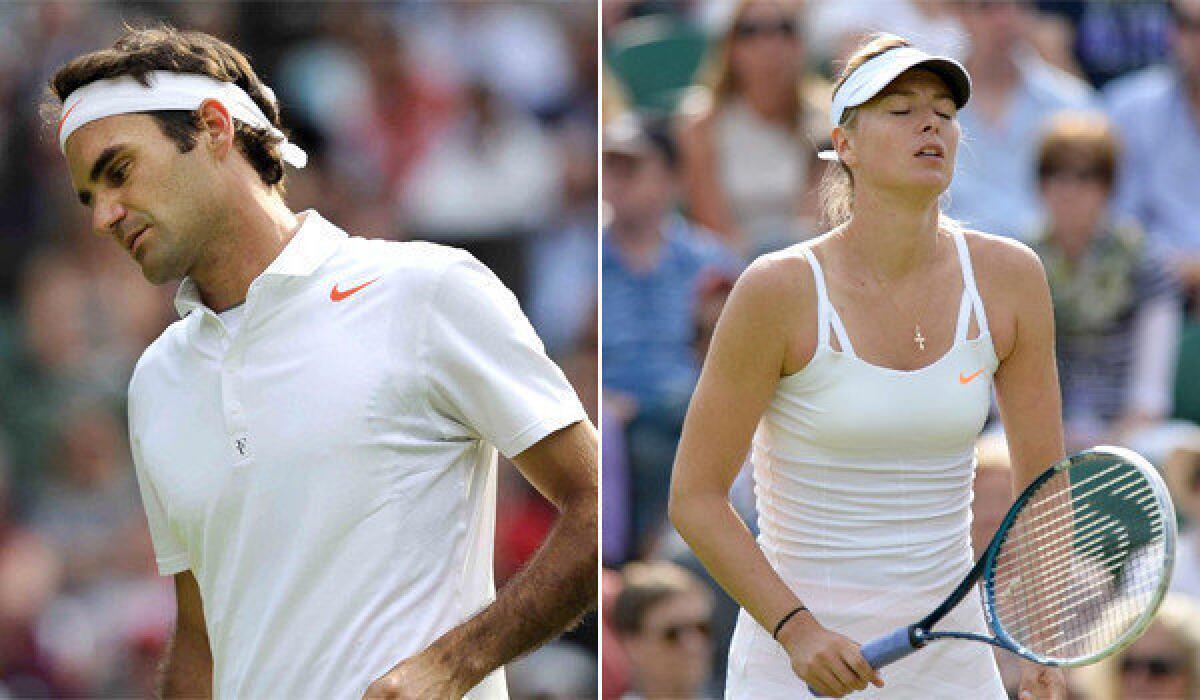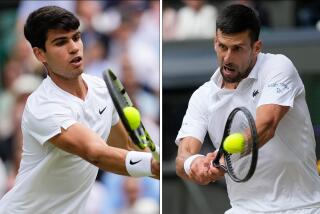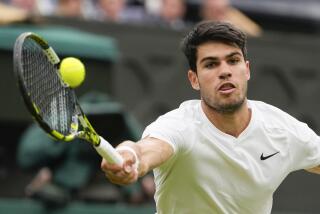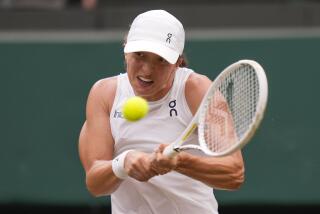Roger Federer, Maria Sharapova suffer upset losses at Wimbledon

- Share via
LONDON — The little world of tennis spun out of control Wednesday. Roger Federer and Maria Sharapova took figurative tumbles at Wimbledon far earlier than anyone believed, and others took actual tumbles on lawns apparently too slick for the purpose.
Federer, who advanced to the quarterfinals in his previous 36 Grand Slam tournaments, was knocked out of Wimbledon this time in the second round. And by a 27-year-old Ukrainian ranked 116th, Sergiy Stakhovsky, 6-7 (5), 7-6 (5), 7-5, 7-6 (5).
“I couldn’t find a way,” said Federer, who last missed a Slam quarterfinal in the 2004 French Open. “I’m happy about the number, but I wish it wasn’t going to end here.”
For Sharapova, third-seeded in the women’s draw — as was Federer in the men’s— defeat was just as unexpected. She lost to Portugal’s Michelle Larcher de Brito, No. 131 in the rankings, 6-3, 6-4.
“She’s someone who plays extremely aggressive,” Sharapova said. “I just wasn’t there.”
Nor, literally, was the No. 2 seed Victoria Azarenka, one of several on an afternoon of sunshine and confusion who withdrew before starting a match or after.
A victim of grass so slippery that Sharapova called it dangerous, Azarenka injured a knee when she tumbled Monday.
The departure of Azarenka, who won the last two Australian Opens, and Sharapova, winner of four Slams including Wimbledon in 2004, virtually gives the women’s title to Serena Williams, the defending champion.
Nobody had given it to Federer, even if he was a surprising winner a year ago, his record seventh Wimbledon title. Yet nobody believed he would be out in the second round, including the 31-year-old Federer.
But Stakhovsky’s 1980s serve-and-volley game — “At least somebody can play that style, still,” Stakhovsky said — kept Federer out of sync.
“I knew he was going to do that,” said Federer, who had faced Stakhovsky once previously — and won. “It’s a tactic you can use if you have a big enough serve, move good enough. You also have to be good from the baseline.... That’s exactly what he was able to do today. I was impressed.”
Very unimpressive but understandable were the withdrawals.
Steve Darcis, who on Monday defeated No. 5 seed and two-time champ Rafael Nadal, announced he couldn’t play because of an injured right shoulder suffered when he dived for a ball. Like that, the man who beat one of the stars was gone, shortly before another of the stars, Federer.
John Isner, who three years ago made history here by winning a match from Nicolas Mahut that lasted 11 hours and 183 games, went only two-plus games against Adrian Mannarino before his left knee went out.
Jo-Wilfried Tsonga trailed Ernests Gulbis 2-1 before departing because of his own knee problem. Radek Stepanek was into a third set against Jerzy Janowicz when what he said were the effects of flu caused him to quit. And Marin Cilic, hobbled by a knee problem, was a no-show for his match against Kenny De Schepper.
“A black day,” surmised Cilic.
Not for Stakhovsky. Or Larcher de Brito, a 20-year-old who perhaps finally is fulfilling the promise of her teens.
“I was happy just to qualify,” Larcher de Brito said. “This is too exciting.”
Stakhovsky knew he couldn’t play Federer’s game, so he made Federer play his game.
“Well, you can’t really keep up with Roger on grass on baseline rallies,” Stakhovsky said. “It’s just impossible, I would say, especially here. ...
“Beating Roger here on his court, where he’s a legend, is I think having definitely a special place in my career.”
But hardly a special place in the career of Federer.
“Just got to get over this one,” he said. “Some haven’t hurt this much. That’s for sure.”
More to Read
Go beyond the scoreboard
Get the latest on L.A.'s teams in the daily Sports Report newsletter.
You may occasionally receive promotional content from the Los Angeles Times.










